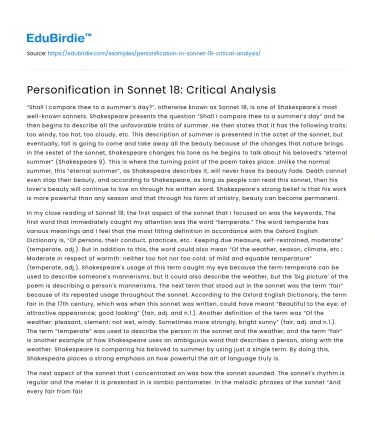“Shall I compare thee to a summer’s day?”, otherwise known as Sonnet 18, is one of Shakespeare's most well-known sonnets. Shakespeare presents the question “Shall I compare thee to a summer’s day” and he then begins to describe all the unfavorable traits of summer. He then states that it has the following traits; too windy, too hot, too cloudy, etc. This description of summer is presented in the octet of the sonnet, but eventually, fall is going to come and take away all the beauty because of the changes that nature brings. In the sestet of the sonnet, Shakespeare changes his tone as he begins to talk about his beloved’s “eternal summer” (Shakespeare 9). This is where the turning point of the poem takes place. Unlike the normal summer, this “eternal summer”, as Shakespeare describes it, will never have its beauty fade. Death cannot even stop their beauty, and according to Shakespeare, as long as people can read this sonnet, then his lover’s beauty will continue to live on through his written word. Shakespeare’s strong belief is that his work is more powerful than any season and that through his form of artistry, beauty can become permanent.
In my close reading of Sonnet 18, the first aspect of the sonnet that I focused on was the keywords. The first word that immediately caught my attention was the word “temperate.” The word temperate has various meanings and I feel that the most fitting definition in accordance with the Oxford English Dictionary is, “Of persons, their conduct, practices, etc.: Keeping due measure, self-restrained, moderate” (temperate, adj.). But in addition to this, the word could also mean “Of the weather, season, climate, etc.: Moderate in respect of warmth: neither too hot nor too cold; of mild and equable temperature” (temperate, adj.). Shakespeare's usage of this term caught my eye because the term temperate can be used to describe someone's mannerisms, but it could also describe the weather, but the 'big picture' of the poem is describing a person's mannerisms. The next term that stood out in the sonnet was the term “fair” because of its repeated usage throughout the sonnet. According to the Oxford English Dictionary, the term fair in the 17th century, which was when this sonnet was written, could have meant “Beautiful to the eye; of attractive appearance; good looking” (fair, adj. and n.1.). Another definition of the term was “Of the weather: pleasant, clement; not wet, windy. Sometimes more strongly, bright sunny” (fair, adj. and n.1.). The term “temperate” was used to describe the person in the sonnet and the weather, and the term “fair” is another example of how Shakespeare uses an ambiguous word that describes a person, along with the weather. Shakespeare is comparing his beloved to summer by using just a single term. By doing this, Shakespeare places a strong emphasis on how powerful the art of language truly is.
Save your time!
We can take care of your essay
- Proper editing and formatting
- Free revision, title page, and bibliography
- Flexible prices and money-back guarantee
The next aspect of the sonnet that I concentrated on was how the sonnet sounded. The sonnet's rhythm is regular and the meter it is presented in is iambic pentameter. In the melodic phrases of the sonnet “And every fair from fair sometime declines, By chance, or nature 's changing course, untrimmed” (Shakespeare 7-8), Shakespeare uses alliteration, and consonance, along with several other poetic devices. These repetitions are used to try and tug on our emotions, produce a certain mood that Shakespeare is aiming for, and underline the central ideas of the sonnet. In the lines previously stated, Shakespeare places an emphasis on the change of beauty that occurs throughout nature. Specifically, when Shakespeare repeats the term “fair”, he is emphasizing the quality or beauty that summer holds. The sonnet rhyme scheme is abab cdcd efef gig, which is a notable part of Shakespeare’s sonnets. Shakespeare’s use of perfect or full rhyme is prominent throughout the sonnet and each line has a clear and concise end. A few examples of Shakespeare's use of perfect rhyme are “dayMay” (Shakespeare 1-3) and “fade shade” (Shakespeare 9-11). The rhyming words that Shakespeare uses have some sort of relationship with each other as well. A few examples of these relationships are, with “dayMay”, there are days in every month and May is a month, and with “fade shade” the shade can cause the light to fade. By establishing these relationships between rhyming words, Shakespeare gives the sonnet more meaning and it helps aid in his argument that his artistry is more powerful and more meaningful than the seasons.
The next aspect that I looked for in my close reading of the sonnet was searching for word order and patterns. One pattern that I found in the sonnet was the use of strong end-stopped lines. The meaning of a line to be end-stopped in poetry is that a clause, sentence, or phrase comes at the conclusion of a line in poetry. An example of an end-stopped line that is presented in the sonnet is “Rough winds do shake the darling buds of May, and summer 's lease hath all too short a date:” (Shakespeare 3-4). Both phrases of the sonnet end with punctuation. I found that the use of end-stopped lines, along with the meter that the poem is presented in, gives the poem a sort-of calming effect on me as a reader. Shakespeare does this purposefully. Shakespeare uses this calming effect to demonstrate just how beautiful his poetry is, and by using this effect, he accomplishes his goal of expressing beauty through his artistry.






 Stuck on your essay?
Stuck on your essay?

